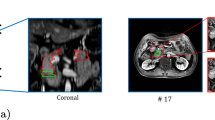Abstract
High-accuracy segmentation of lesions in pancreatic images is essential for computer-aided precision diagnosis and treatment. The segmentation accuracy of deep learning-based segmentation models depends on the number of annotated pancreatic tumor images. Due to the high cost of labeling, the size of the training set for segmentation models is usually small. This paper proposes an image augmentation model based on local region texture generation. For pancreas images (background) and tumor images (foreground) with ablated regions, the model can generate image textures for the remaining blank areas after combining the two images to obtain new samples. To improve the texture continuity between the tumor region and surrounding tissues in the generated image, this paper constructs a three-level loss function to constrain the training of the augmented model. Simulation experiments on the pancreatic tumor image set provided by the partner hospital show that the Dice coefficient of the segmentation model trained on the dataset augmented by the proposed model improves by 2.4% compared with the current optimal method when the number of real images is sparse, which proves its effectiveness and feasibility.
This work is supported in part by the National Natural Science Foundation of China (U20A20171, 61802347, 61972347, 62106225), and the Natural Science Foundation of Zhejiang Province (LY21F020027, LGF20H180002, LGG20F020017, LY20H18006, LSD19H180003).
Access this chapter
Tax calculation will be finalised at checkout
Purchases are for personal use only
Similar content being viewed by others
References
Ferlay, J., et al.: Cancer statistics for the year 2020: an overview. Int. J. Cancer 149, 778–789 (2021)
Sindhu, A., Radha, V.: Pancreatic tumour segmentation in recent medical imaging – an overview. In: Smys, S., Tavares, J.M.R.S., Balas, V.E., Iliyasu, A.M. (eds.) Computational Vision and Bio-Inspired Computing. AISC, vol. 1108, pp. 514–522. Springer, Cham (2020). https://doi.org/10.1007/978-3-030-37218-7_58
Goodfellow, I.J., et al.: Generative adversarial networks. Adv. Neural. Inf. Process. Syst. 3, 2672–2680 (2014)
Yi, X., Walia, E., Babyn, P.: Generative adversarial network in medical imaging: a review. Med. Image Anal. 58, 101552 (2019)
Bissoto, A., Valle, E., Avila, S.: GAN-based data augmentation and anonymization for skin-lesion analysis: a critical review. In: Proceedings of the IEEE/CVF Conference on Computer Vision and Pattern Recognition, pp. 1847–1856 (2021)
Chen, Y., et al.: Generative adversarial networks in medical image augmentation: a review. Comput. Biol. Med. 144, 105382 (2022)
Lin, C., et al.: Breast mass detection in mammograms via blending adversarial learning. In: Burgos, N., Gooya, A., Svoboda, D. (eds.) Simulation and Synthesis in Medical Imaging. LNCS, vol. 11827, pp. 52–61. Springer, Cham (2019). https://doi.org/10.1007/978-3-030-32778-1_6
Wu, E., Wu, K., Cox, D., Lotter, W.: Conditional infilling GANs for data augmentation in mammogram classification. In: Stoyanov, D., et al. (eds.) Image Analysis for Moving Organ, Breast, and Thoracic Images. LNCS, vol. 11040, pp. 98–106. Springer, Cham (2018). https://doi.org/10.1007/978-3-030-00946-5_11
Guan, Q., et al.: Medical image augmentation for lesion detection using a texture-constrained multichannel progressive GAN. Comput. Biol. Med. 145, 105444 (2022)
Xing, Y., et al.: Adversarial pulmonary pathology translation for pairwise chest X-ray data augmentation. In: Shen, D., et al. (eds.) Medical Image Computing and Computer Assisted Intervention – MICCAI 2019. LNCS, vol. 11769, pp. 757–765. Springer, Cham (2019). https://doi.org/10.1007/978-3-030-32226-7_84
Yao, Q., Xiao, L., Liu, P., Zhou, S.K.: Label-free segmentation of COVID-19 lesions in lung CT. IEEE Trans. Med. Imaging 40, 2808–2819 (2021)
Ambita, A.A.E., Boquio, E.N.V., Naval, P.C.: COViT-GAN: vision transformer for COVID-19 detection in CT scan images with self-attention GAN for data augmentation. In: Farkaš, I., Masulli, P., Otte, S., Wermter, S. (eds.) Artificial Neural Networks and Machine Learning – ICANN 2021. LNCS, vol. 12892, pp. 587–598. Springer, Cham (2021). https://doi.org/10.1007/978-3-030-86340-1_47
Ronneberger, O., Fischer, P., Brox, T.: U-Net: convolutional networks for biomedical image segmentation. In: Navab, N., Hornegger, J., Wells, W.M., Frangi, A.F. (eds.) Medical Image Computing and Computer-Assisted Intervention – MICCAI 2015. LNCS, vol. 9351, pp. 234–241. Springer, Cham (2015). https://doi.org/10.1007/978-3-319-24574-4_28
Liu, Y., Jia, X., Shen, L., Ming, Z., Duan, J.: Local normalization based BN layer pruning. In: Tetko, I.V., Kůrková, V., Karpov, P., Theis, F. (eds.) Artificial Neural Networks and Machine Learning – ICANN 2019: Deep Learning. LNCS, vol. 11728, pp. 334–346. Springer, Cham (2019). https://doi.org/10.1007/978-3-030-30484-3_28
Chen, C., Hammernik, K., Ouyang, C., Qin, C., Bai, W., Rueckert, D.: Cooperative training and latent space data augmentation for robust medical image segmentation. In: de Bruijne, M., et al. (eds.) Medical Image Computing and Computer Assisted Intervention – MICCAI 2021. LNCS, vol. 12903, pp. 149–159. Springer, Cham (2021). https://doi.org/10.1007/978-3-030-87199-4_14
Gilbert, A., Marciniak, M., Rodero, C., Lamata, P., Samset, E., Mcleod, K.: Generating synthetic labeled data from existing anatomical models: an example with echocardiography segmentation. IEEE Trans. Med. Imaging 40, 2783–2794 (2021)
Author information
Authors and Affiliations
Corresponding authors
Editor information
Editors and Affiliations
Rights and permissions
Copyright information
© 2022 The Author(s), under exclusive license to Springer Nature Switzerland AG
About this paper
Cite this paper
Wei, Z. et al. (2022). Pancreatic Image Augmentation Based on Local Region Texture Synthesis for Tumor Segmentation. In: Pimenidis, E., Angelov, P., Jayne, C., Papaleonidas, A., Aydin, M. (eds) Artificial Neural Networks and Machine Learning – ICANN 2022. ICANN 2022. Lecture Notes in Computer Science, vol 13530. Springer, Cham. https://doi.org/10.1007/978-3-031-15931-2_35
Download citation
DOI: https://doi.org/10.1007/978-3-031-15931-2_35
Published:
Publisher Name: Springer, Cham
Print ISBN: 978-3-031-15930-5
Online ISBN: 978-3-031-15931-2
eBook Packages: Computer ScienceComputer Science (R0)




